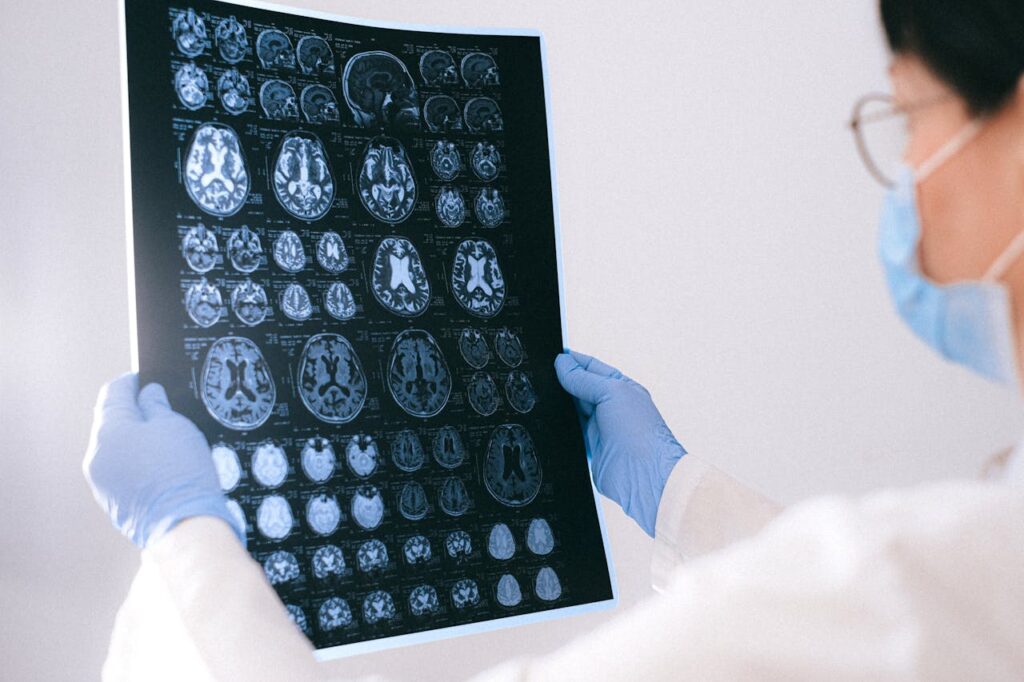
Alzheimer’s disease is a type of progressive neurocognitive impairment and is the most common degenerative brain disorder. Dementia symptom of Alzheimer’s disease and includes a general decline or loss of the ability to think, remember, and reason. At least 50 percent of all older adults with dementia have Alzheimer’s disease, and more than 50 million people around the world are living with Alzheimer’s disease and other related causes of neurocognitive decline.
Alzheimer’s is a progressive disease in which abnormal proteins build amyloid plaques and tau tangles in the brain, damaging neurons (nerve cells) in certain parts of the brain and causing them to deteriorate and die. Because of what happens to these neurons, people with Alzheimer’s can interpret their environment differently and act unpredictably. They experience a type of a mental deterioration that includes the loss of memories and inability to think clearly.
Although people younger than 65 years of age can develop Alzheimer’s, it is primarily associated with advanced age. A person who is younger than 65 and is diagnosed with Alzheimer’s has early onset or younger onset Alzheimer’s. This form of Alzheimer’s can occur as early as 30 years of age. It is usually caused by inheriting one of three defective or mutated genes. At least 5 million people in the United States have the disease. However, an exact number is unknown because Alzheimer’s is often diagnosed incorrectly or not diagnosed until the disease has reached a late stage. Up to half of the people who have Alzheimer’s have not yet been diagnosed with the disease. In the United States, more women have Alzheimer’s than men. However, this seems to be related to the fact that women live longer than men. It also seems to be more common among African Americans. Because of an aging population, the number of people diagnosed with Alzheimer’s will increase more than three times by 2050 to at least 16 million.
CAUSES AND SYMPTOMS
The exact causes of Alzheimer’s are unknown. It is generally accepted that Alzheimer’s is caused by a combination of genetic, environmental, and lifestyle factors. Fewer than 5% of people with the disease inherit it.
The symptoms of Alzheimer’s can be grouped into three general types. They are related to brain function, behavioral and psychiatric issues, and daily life activities.
Symptoms related to brain function include:
- poor memory
- loss of language (such as not remembering the name of objects and/or repeating the same word or phrase over and over again)
- loss of the ability to do voluntary movements such as brushing teeth
- loss of the ability to recognize people who should be known
Symptoms related to behavior and psychiatric issues include:
- depression
- delusions
- wandering
- hallucinations
- aggression
- emotional overreactions to events
Symptoms related to daily activities include trouble with:
- eating
- shopping
- personal care (such as bathing, grooming, using the toilet, and personal hygiene)
DIAGNOSIS
Medical professionals diagnose Alzheimer’s by observation and tests related to the brain, including those that show changes in the structure and size of the brain. Physicians rule out other causes for dementia symptoms and changes in the brain through blood, urine, and imaging tests, and evaluations related to issues such as depression and delirium.
Identifying Alzheimer’s disease earlier, while symptoms are mild, has been a goal of the Alzheimer’s Association. Doctors combine information from the patient’s history, physical examination, and answers in a brief cognitive assessment. The assessment takes five minutes or less and involves a series of questions and might ask the patient to draw a clock face. The activities are designed to spot dementia while it is early. Some older patients might be given the assessment if they show signs of cognitive impairment. All patients on Medicare (age 65 and older) receive a mini-assessment as part of their annual exam. Though doctors can accurately diagnose suspected Alzheimer’s in the living, the disease cannot be confirmed until after death. A brain autopsy and an examination of brain tissue by a specialized pathologist is the only way of confirming that someone had the disease.
RISK FACTORS
Some risk factors seem to play a role in determining if you get the disease. For example, the biggest risk factor for Alzheimer’s is aging. The risk of getting Alzheimer’s increases after the age of 65 and greatly increases after the age of 75. In recent decades, research has emphasized the effect of lifestyle on Alzheimer’s disease risk. According to physicians, the following five lifestyle factors can reduce risk or delay start of the dementia:
- never smoking or quitting smoking
- regular exercise (150 minutes per week of moderate to vigorous intensity)
- light or moderate use of alcohol (one drink a day for women and no more than two a day for men)
- eating high-quality foods such as green leafy vegetables, whole grains, seafood such as in the Mediterranean diet
- late-left brain activities, such as reading, writing letters and playing games that require cognition
Other risk factors for Alzheimer’s include a family history of Alzheimer’s or Parkinson’s disease. Brain damage from head trauma like a concussion or small strokes can also be a risk factor. The chance of developing the disease increases when people have low educational and occupational achievement. High blood pressure combined with high cholesterol, obesity, and a mild cognitive impairment put some people at greater risk of getting the disease as well. The mutation of certain genes leads to a greater chance of developing Alzheimer’s in certain people.
STAGES
Though everyone with Alzheimer’s experiences the disease differently, the disease generally takes the same course and goes through seven stages. People who have early onset Alzheimer’s go through these stages more rapidly than those who have late onset Alzheimer’s.
The disease usually starts slowly, and the middle stages of Alzheimer’s begin about two or three years after the disease begins. Alzheimer’s usually runs its course in eight to ten years, though in some cases it can take 20 to 25 years to get through all the stages.
The stages are:
- No real change in function or other symptoms.
- Functioning mostly normally but with a subtle decline in intellectual function.
- Struggling to complete complex tasks that involve mental and intellectual function as the disease becomes more present.
- Moving from early Alzheimer’s to a mild form of the disease, and needing help with tasks like paying bills.
- Experiencing moderate Alzheimer’s, and requiring help in making basic life decisions that come up daily such as what clothing to put on that is appropriate for the weather.
- Experiencing moderately severe Alzheimer’s and needing help in basic functions like bathing and using the toilet.
- Experiencing severe Alzheimer’s, which includes the nearly complete loss of vocabulary and the ability to walk. The person becomes dependent on others for care.
As Alzheimer’s reaches its end, the disease affects the brain stem. A person loses the ability to digest food, breathe, and expel waste and spends most of the time sleeping. Death from this disease is usually from an infection, pneumonia, or lack of nutrition. Sometimes, the person just stops breathing.
TREATMENT
There is no known cure for this disease. None of the effects of Alzheimer’s can be reversed, so once the symptoms are present, there is no chance of recovery.
Treatments for Alzheimer’s focus on slowing the progression of the disease and helping the person with the disease to function independently for as long as possible. An early diagnosis can aid in this process. Treatments for Alzheimer’s include establishing daily routines, good nursing care, help with sleeping, and physical and emotional support. Certain drugs, such as cholinesterase inhibitors (Aricept, Razadyne, and Exelon) can improve brain function. Memantine (Namenda) and a combination drug called Namzaric can help people with moderate to severe Alzheimer’s disease. Music, light, and cognitive therapies are also helpful, as is sensory stimulation.
Resources
Websites
“Alzheimer’s and Dementia.” Alzheimer’s Association. https://alz.org/alzheimer_s_dementia (accessed August 25, 2023).
“Alzheimer’s Disease.” Cleveland Clinic. December 10, 2022. https://my.clevelandclinic.org/health/diseases/9164-alzheimers-disease (accessed August 25, 2023).
“Alzheimer disease.” MedlinePlus Medical Encyclopedia. January 23, 2022. https://medlineplus.gov/ency/article/000760.htm (accessed August 25, 2023).
“Alzheimer’s Disease and Related Dementias.” Centers for Disease Control and Prevention. October 26, 2020. https://www.cdc.gov/aging/aginginfo/alzheimers.htm (accessed August 25, 2023).
“Alzheimer’s disease.” Mayo Clinic. February 2, 2023. https://www.mayoclinic.org/diseases-conditions/alzheimers-disease/symptoms-causes/syc-20350447 (accessed August 25, 2023).
“Alzheimer’s Disease Fact Sheet.” National Institute on Aging. April 5, 2023. https://www.nia.nih.gov/health/alzheimers-disease-fact-sheet (accessed August 25, 2023).
Lakhan, Shaheen E. “Alzheimer Disease.” Medscape. July 7, 2023. https://emedicine.medscape.com/article/1134817-overview (accessed August 25, 2023).
Organizations
Alzheimer’s Association, 225 N. Michigan Ave. Floor 17, Chicago, IL, 60601, (800) 272-3900, https://alz.org .
Alzheimer’s Foundation of America, 322 Eighth Ave., 16th Floor, New York, NY, 10001, (866) 232-8484, https://alzfdn.org .
National Institute on Aging, Building 31, Room 5C27, 31 Center Drive, MSC 2292, Bethesda, MD, 20892, (800) 222-2225, https://www.nia.nih.gov/ .
Petrusso, Annette, and Teresa Odle. “Alzheimer’s disease.” Gale Health and Wellness Online Collection, Gale, 2023. Gale Health and Wellness, link.gale.com/apps/doc/CWGCPF525427781/HWRC?u=slnsw_public&sid=bookmark-HWRC&xid=205ecb33. Accessed 1 Aug. 2024.
